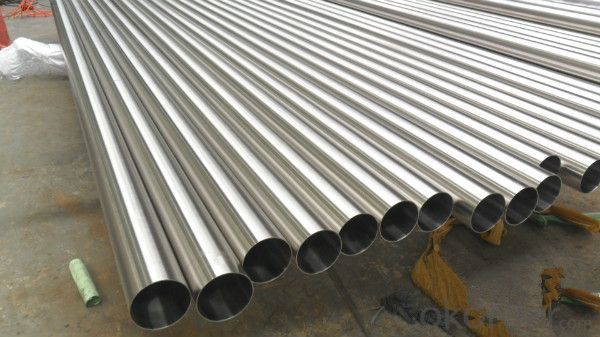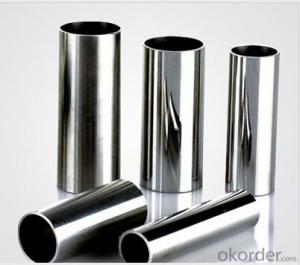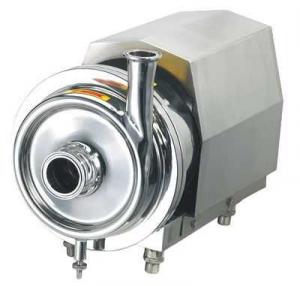Stainless Steel Sanitary Tubing ISO 2037/DIN11850
- Loading Port:
- Ningbo
- Payment Terms:
- TT OR LC
- Min Order Qty:
- 25 m.t.
- Supply Capability:
- 5000 m.t./month
OKorder Service Pledge
OKorder Financial Service
You Might Also Like
1、Structure of Stainless Steel Sanitary Tubing ISO 2037/DIN11850 Description:
Stainless steel sanitary tubing is often used in applications found in the biotech, pharma, and food/beverage industries. Sanitary tubing must be somewhat inert not to react to the chemical that pass through the tubing itself. Sanitary tubing is used in conjunction with stainless sanitary fittings.2、Main Features of the Stainless Steel Sanitary Tubing ISO 2037/DIN11850:
• High manufacturing accuracy
• High strength
• Small inertia resistance
• Good visual effect
•Reasonable price
3、Stainless Steel Sanitary Tubing ISO 2037/DIN11850 Images:



4、Stainless Steel Sanitary Tubing ISO 2037/DIN11850 Specification:
Size:
| Outside diameter | Thickness(mm) | |||||
| (inch) | (mm) | 1 | 1.5 | 2 | 2.5 | 3 |
| 3/4′ | 19.1 | |||||
| 7/8′ | 22.2 | |||||
| 1′ | 25.4 | |||||
| 1-1/8′ | 28.6 | |||||
| 1-1/4′ | 31.8 | |||||
| 1-1/2′ | 38.1 | |||||
| 40 | ||||||
| 45 | ||||||
| 2 | 50.8 | |||||
| 52 | ||||||
| 2-1/4′ | 57.15 | |||||
| 2-1/8′ | 60.3 | |||||
| 2-1/2′ | 63.5 | |||||
| 70 | ||||||
| 3 | 76.2 | |||||
| 85 | ||||||
| 3-1/2′ | 88.9 | |||||
| 4′ | 101.6 | |||||
| 4-1/8′ | 104.78 | |||||
| 4-1/4′ | 107.95 | |||||
| 4-1/2′ | 114.3 | |||||
| 5-1/4′ | 133.35 | |||||
| 6-1/4′ | 158.75 | |||||
| 8-5/8′ | 219.08 | |||||
Tolerances on dimensions table:
| Outside diameter | Thickness | Length | |
| <25.40mm | ±0.13mm | ±10.00% | OD<101.60mm +3.20mm -0mm OD≥101.60mm +4.80 -0mm |
| ≥25.40mm~50.80mm | ±0.20mm | ||
| ≥50.80mm~76.20mm | ±0.25mm | ||
| ≥76.20mm~101.60mm | ±0.38mm | ||
| ≥101.60mm~139.70mm | ±0.38mm | ||
| ≥139.70mm~203.20mm | ±0.76mm | ||
| ≥203.20mm~304.80mm | ±1.27mm | ||
5、FAQ of Stainless Steel Sanitary Tubing ISO 2037/DIN11850:
①How is the quality of your products?
Our products are manufactured strictly according to national and internaional standard, and we take a test on every pipe before delivered out. If you want see our quality certifications and all kinds of testing report, please just ask us for it.
Guaranteed: If products’ quality don’t accord to discription as we give or the promise before you place order, we promise 100% refund.
②How about price?
Yes, we are factory and be able to give you lowest price below market one, and we have a policy that “ for saving time and absolutely honest business attitude, we quote as lowest as possible for any customer, and discount can be given according to quantity”,if you like bargain and factory price is not low enough as you think, just don’t waste your time.Please trust the quotation we would give you, it is professional one.
③Why should you chose us?
Chose happens because of quality, then price, We can give you both.Additionally, we can also offer professional products inquiry, products knowledge train(for agents), smooth goods delivery, exellent customer solution proposals.Our service formula: good quality+good price+good service=customer’s trust
SGS test is available, customer inspection before shipping is welcome, third party inspection is no problem.
Any question, pls feel free to contact us !
- Q: Can stainless steel pipes be used for air conditioning systems?
- Yes, stainless steel pipes can be used for air conditioning systems. Stainless steel is known for its corrosion resistance, durability, and ability to handle high temperatures, making it a suitable material for air conditioning systems. It helps maintain the quality of air and prevents contamination due to its non-reactive nature. Additionally, stainless steel pipes offer excellent mechanical strength and are resistant to damage caused by external factors such as moisture or chemicals.
- Q: Can stainless steel pipes be used for swimming pool systems?
- Yes, stainless steel pipes can be used for swimming pool systems. Stainless steel is highly resistant to corrosion, making it an ideal choice for pool applications where exposure to chlorine and other chemicals is common. Additionally, stainless steel pipes offer durability, longevity, and excellent performance in high-temperature environments, making them a reliable option for swimming pool systems.
- Q: Can stainless steel pipes be stress relieved?
- Yes, stainless steel pipes can be stress relieved. Stress relieving is a heat treatment process that helps to reduce residual stresses in the material, improving its mechanical properties and reducing the risk of cracking or distortion. This process can be applied to stainless steel pipes to enhance their performance and durability.
- Q: Can stainless steel pipes be used in the water treatment industry?
- Indeed, the water treatment industry can utilize stainless steel pipes. Due to its exceptional resistance to corrosion, stainless steel proves to be a fitting material for environments involved in water treatment and processing. It finds widespread application within the industry, encompassing pipelines, pumps, valves, and tanks. The strength and durability of stainless steel pipes are commendable, guaranteeing enduring performance even under severe circumstances. Moreover, stainless steel boasts hygienic properties and is effortless to clean, which renders it perfect for applications where upholding water purity is paramount. All in all, stainless steel pipes emerge as a dependable and cost-efficient alternative for the water treatment industry.
- Q: Stainless steel welded pipe or seamless pipe expensive?
- Stainless steel is generally divided into three categories: martensitic stainless steel, ferritic stainless steel, austenitic stainless steel, duplex stainless steel and precipitation hardening stainless steel. The price is roughly the same order as stainless steel. But each category has a cheaper and more expensive one, and the difference can be great.
- Q: Stainless steel pipe is mainly used in what areas?
- The stainless steel pipe is a kind of economic section steel, is one of the most important products in the steel industry, which can be widely used in industrial and living decoration on the market, a lot of people for the production of staircase handrails, railings, window, furniture etc.. There are two kinds of materials, 201 and 304.
- Q: What is the difference between seamless and seamless stainless steel pipes?
- The difference between seamless and seamless stainless steel pipes lies in the manufacturing process and the composition of the material used. Seamless pipes are manufactured by extruding a solid billet through a piercing rod to create a hollow tube. This process eliminates the need for any welds or joints, resulting in a continuous and smooth pipe with no weak points. Seamless pipes are known for their strength, durability, and ability to withstand high-pressure and high-temperature applications. They are commonly used in industries such as oil and gas, petrochemical, and power generation. On the other hand, seamless stainless steel pipes are a specific type of seamless pipe that is made from stainless steel. Stainless steel is an alloy that contains a high percentage of chromium, which provides excellent corrosion resistance and high-temperature strength. This makes seamless stainless steel pipes suitable for applications where resistance to corrosion, oxidation, and heat is crucial, such as in the food and beverage, pharmaceutical, and chemical industries. In summary, while both seamless and seamless stainless steel pipes are manufactured through a seamless process, the difference lies in the material used. Seamless stainless steel pipes offer the added benefits of corrosion resistance and high-temperature strength due to their stainless steel composition.
- Q: How do stainless steel pipes compare to polyethylene pipes?
- Stainless steel pipes and polyethylene pipes are two commonly used materials for various plumbing and industrial applications. While both materials have their advantages and disadvantages, they differ in terms of strength, durability, cost, and application suitability. Stainless steel pipes are known for their exceptional strength and durability. They can withstand high pressure and temperature, making them suitable for applications in industries such as oil and gas, chemical processing, and water distribution. Stainless steel pipes are also resistant to corrosion, rust, and fire, making them a reliable choice for long-term use. However, they tend to be heavier and more expensive than polyethylene pipes. On the other hand, polyethylene pipes are lightweight, flexible, and relatively inexpensive compared to stainless steel pipes. They are commonly used in applications such as irrigation, water supply, and drainage systems. Polyethylene pipes are resistant to chemicals, impact, and abrasion, making them suitable for underground installation. However, they may not be as durable as stainless steel pipes and may require more frequent replacements or repairs in some cases. In terms of installation and maintenance, stainless steel pipes are generally more demanding as they require specialized tools and skills. Polyethylene pipes, on the other hand, are easier to install and maintain due to their flexibility and simple jointing techniques. Ultimately, the choice between stainless steel pipes and polyethylene pipes depends on the specific requirements of the application. If strength, durability, and resistance to extreme conditions are crucial, stainless steel pipes are the preferred option. For less demanding applications that require cost-effectiveness, flexibility, and ease of installation, polyethylene pipes may be more suitable. It is important to consider factors such as budget, operating conditions, lifespan, and maintenance requirements when comparing these two pipe materials.
- Q: What is the maximum diameter for a stainless steel pipe?
- The maximum diameter for a stainless steel pipe can vary depending on the manufacturing capabilities and specifications, but commonly ranges from a few millimeters to several feet.
- Q: Can stainless steel pipes be painted or coated?
- Indeed, it is possible to paint or coat stainless steel pipes. However, it is vital to opt for a suitable paint or coating specifically formulated for stainless steel surfaces. This is because stainless steel possesses a smooth and non-porous surface, which can pose a challenge for proper adherence of paint or coatings. Moreover, stainless steel pipes may encounter harsh environmental conditions, such as elevated temperatures or corrosive substances, thus necessitating the use of a paint or coating that is resistant to these elements. By selecting the appropriate paint or coating and employing correct surface preparation techniques, one can effectively enhance the appearance of stainless steel pipes or provide them with added protection against corrosion.
Send your message to us
Stainless Steel Sanitary Tubing ISO 2037/DIN11850
- Loading Port:
- Ningbo
- Payment Terms:
- TT OR LC
- Min Order Qty:
- 25 m.t.
- Supply Capability:
- 5000 m.t./month
OKorder Service Pledge
OKorder Financial Service
Similar products
Hot products
Hot Searches
Related keywords




























